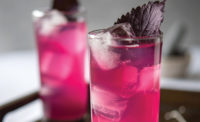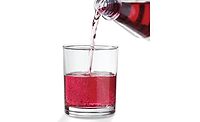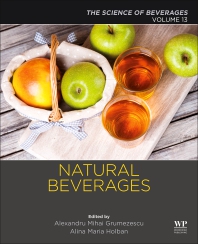Formulating with natural colors

DöhlerGroup added a new range of red hues called Red Brilliance to its natural color collection. These hues are derived from the coloring concentrate of black carrot.

Wild Flavors’ natural, acid-stable blue color enables the development of a variety of green, purple, brown and black hues.

Sensient Colors made a capital investment in aseptic packaging, which offers beverage developers preservative-free colors with an extended shelf life and sustainability.



On a typical episode of culinary TV show “Masterchef,” home chefs work hard to create something delicious for renowned chefs Gordon Ramsay, Joe Bastianich and Graham Elliot. However, oftentimes only the dishes that look the tastiest make it to the judges’ table. Similarly, consumers often select foods and beverages based on their appearances, such as the color of the liquid inside the bottle.
According to a statement, Ted Nixon, chief executive officer of D.D. Williamson, Louisville, Ky., often says: “If food does not taste good, people will not try it again. If it doesn’t look good, they may not try it at all.” This reasoning helps to explain not only why color is so important for foods and beverages, but also how it impacts consumer purchases.
Because the taste of foods and beverages is complemented by color, it must align with consumers’ expectations, says Christian Benetka Uher, senior product manager of colors for DöhlerGroup, Darmstadt, Germany. “That is why the color of almost all orange-based beverages is orange and why tomato ketchup is (generally) red,” he says. “But there are some exceptions: for example, green ketchup or a blue beverage. Such products can actually attract consumers by their unusual and, therefore, interesting color hue.”
Seeing red
Nevertheless, the most important colors for beverages are red, yellow, orange and brown, DöhlerGroup’s Uher says.
The most commonly requested natural food colorant for beverages is red, adds Stefan Hake, chief executive officer of Tarrytown, N.Y.-based GNT USA Inc., citing Faber Birren’s book titled “Color Psychology and Color Therapy: A Factual Study of the Influence of Color on Human Life.” The book also states that the color red is widely known as an appetite stimulant and has the ability to command human attention. Additionally, it brings naturally red fruits and vegetables to consumers’ minds, Hake says.
“While red is ‘universally appealing,’ demand for different colors is inextricably linked to the intended market segment,” he explains. “Beverage products targeted to children that want to reflect fun and whimsy or sports drinks that convey a ‘refueling’ message often demand a greater variety of colors, including yellow, orange, green and blue. On the other hand, beverage products conveying a ‘natural’ or ‘clean label’ message must consider colors that stick to that message, such as red, purple, orange and yellow.”
Chad Ford, product manager of colors at Wild Flavors Inc., Erlanger, Ky., agrees that red is the most popular color for beverage applications, adding that consumers also are attracted to vibrant shades of color. “By making a product have a full, vibrant color, there is an increased perception of freshness and intensity,” he explains.
Orange, yellow and pink colors — as well as the color red — exist in nature, which fulfills consumers’ sensory expectations, says Emina Goodman, technical support manager for the beverage and dairy group at Sensient Colors LLC, St. Louis. Therefore, in addition to red, consumers are attracted to these colors, she says.
“We’ve also seen a recent trend toward peach and coral tones, which is indicative of the Pantone Color of the Year, Tangerine Tango,” she says.
Similarly, ColorMaker Inc., a partner of D.D. Williamson, receives requests for various shades of red, purple and orange most often. It also gets some requests for yellow colors in lemon-flavored beverages, says Stephen Lauro, president of the Anaheim, Calif.-based company.
“Interestingly, while our company holds a U.S. patent on a natural blue color, there is little demand for [ready-to-drink] (RTD) blue beverages,” he says. “Almost all of our natural blue color is sold in powdered form for use in dry beverages.”
According to Jeff Greaves, president of Food Ingredient Solutions LLC, Teterboro, N.J., U.S. consumers prefer bright colors, whereas consumers in the European Union and Japan prefer pastel shades.
However, consumer preferences in the United States might be making a change.
Natural beauty
“It appears we have turned a corner in the consumer’s perception of natural colors,” ColorMaker’s Lauro says. “Consumers no longer see naturally colored products as dull, pastel or muted. Rather, they now see artificially colored products as intensely bright and unappealing.
“In two different consumer research panels conducted by our company this past spring and summer, we learned that many consumers find American food too brightly colored — to the point where some consumers are becoming suspicious,” he continues. “This data is very interesting to us as it indicates that consumers may have finally learned a new color standard: softer, more natural color.”
Other factors also have aided in the increased popularity of natural colors. In June, D.D. Williamson asked 97 food industry technologists: “What is the most common reason your company uses natural coloring in applications?” Three answers tied with 20.6 percent of the vote: “To offset colors that may be lost in storage and distribution”; “To reduce variations in color from sourcing or processing”; and “To enhance naturally occurring colors.” Nearly 20 percent responded, “To provide a product’s flavor identity”; 13.4 percent said, “To color products that are colorless”; and 5.2 percent answered, “To protect sensitive flavors or vitamins.”
“We are surprised with the even division at the top,” said Campbell Barnum, vice president of D.D. Williamson, in a statement. “The results validate that product developers have multiple reasons to formulate natural coloring in foods and beverages.”
Furthermore, the 2007 Southampton study impacted foods and beverages for both manufacturers and consumers, according to experts. The study indirectly linked the consumption of synthetic azo dyes to hyperactivity in children, says Byron Madkins, senior director of product development and applications for Chr. Hansen Inc., Milwaukee. As a result, many global food and beverage manufacturers operating in Europe and other parts of the world, including the United States, stopped using the affected colors.
In Europe, products containing azo dyes that are targeted at children must carry the claim “May have an adverse effect on activity and attention in children,” explains DöhlerGroup’s Uher. Therefore, the demand for artificial colors and especially azo dyes is decreasing, he says.
Similarly, on Jan. 7, 2012, California Proposition 65 began enforcing the listing of 4-Methylimidazole (4MeI) — a low molecular weight compound that is present in Class III and Class IV Caramel Colors — as a possible carcinogen, which impacted many beverages. Although Lincolnwood, Ill.-based Sethness Products Co. believes the decision by the Office of Environmental Health Hazard Assessment is based on poor science, it has noticed an increase in requests for low 4-MeI caramel colors. In preparation for the ruling, the company spent more than three years developing low 4-MeI alternatives for its Class IV liquid and powdered caramel colors.
These events have left the color industry with the challenge and opportunity to develop a wide range of colors from natural sources, experts say.
Additionally, artificial colors are limited, so natural colors often are used to extend the palette, says Food Ingredient Solutions’ Greaves. However, he notes that both natural and artificial color usages continue to increase, but natural is growing more quickly because, in most cases, it takes 10 to 40 times as much natural color to replace an artificial color, he says.
To answer the consumer demand for natural ingredients, GNT USA offers Exberry, a line of natural colors made from fruits and vegetables.
“From a technical perspective, increasing demand for natural colors has resulted in a greater variety of color shades, improved intensity, better stability and an overall improvement in technical capabilities,” GNT USA’s Hake says.
Formulation tidbits
Nevertheless, developing natural colors comes with its difficulties. The biggest challenge and demand from customers is to create a variety of natural colors that are stable, high-quality and last long-term, DöhlerGroup’s Uher says. To do so, the type of beverage and ingredients in that beverage must be considered. For instance, anthocyanin-based colors are not stable in the presence of high levels of ascorbic acid; however, beta carotene emulsions are stabilized by the presence of high levels of ascorbic acid, Chr. Hansen’s Madkins explains. Similarly, there are ingredients that can interact with artificial colors, causing them to break down and demonstrate a loss in color, he says.
“It is important to know the types of ingredients that may interact with the color and ensure that the color(s) will be stable in the presence of these ingredients,” Madkins says.
The pH and clarity of the product are the biggest concerns for beverage-makers, adds Terry L. Geerts, application chemist for Sethness Products.
When deciding whether to use artificial or natural colors in a beverage application, manufacturers should consider the cost of the ingredient and the look they’re trying to achieve, Wild Flavors’ Ford advises.
The cost of bringing the raw material (e.g. fruit or vegetable) to market versus producing in a lab can come with a cost, Ford says. "Use rates are typically higher with [natural] colors as there is more ‘stuff’ that comes along with them besides just pure pigment,” he explains. “Also, many manufacturers expect exact matches to their current products. [Natural] colors may not always achieve the same vivid, ‘artificial’ look that comes with some [artificial] colors, though they may be in the same ballpark. So, if manufacturers are unwilling to compromise on cost-in-use and potential shade differences, it may make more sense to stick with [artificial] colors.”
To overcome possible stability issues with natural colors, suppliers have developed unique processes and techniques.
DöhlerGroup’s own fruit processing and global raw material sourcing guarantee preferential access to natural fruit and vegetable ingredients, which enables it to blend different natural colors and coloring concentrates to produce the same stable quality consistently, Uher adds. For instance, DöhlerGroup added a new range of red hues called Red Brilliance to its natural color collection. These hues are derived from the coloring concentrate of the black carrot, the company says.
Sensient Colors works to improve the vibrancy and stability of its natural colors by developing more stable botanical sources, identifying new sources and developing new plant hybrids, Goodman says. Selective plant breeding programs and new hybrid creation are important factors in producing more stable botanical sources, she says.
“A majority of Sensient’s natural colors are genetically-modified-organism-free, preservative-free, kosher and allergen-free,” Goodman says. “We know that people want cleaner, more wholesome ingredients in their products, and we also know that natural colors possess compounds that promote health and wellness. We offer a complete portfolio of natural colors like carotenoids and anthocyanins, which capture many of the healthy attributes inherent in colors derived from fruits and vegetables, such as antioxidants, vitamins and polyphenols.”
Furthermore, intensity and stability have improved with the development of stable microemulsion carotenoids, improved antioxidant and co-pigment systems, and the advent of diacylated anthocyanins such as red radish and purple sweet potato, Food Ingredient Solutions’ Greaves says.
Additionally, natural colors have improved in stability over the years due to the use of tocopherols, rosemary extracts, specialized gum systems, higher-yield extractions and higher-yield vegetables, ColorMaker’s Lauro says. And as ingredient technology has grown, so has processing technology, he adds.
“Today’s beverages are processed via ultra-filtration or [high temperature short time] (HTST) or other technologies unique to that particular beverage bottling line,” Lauro explains. “We are slowly overcoming the technical challenges encountered with the use of natural colors and thereby meeting, perhaps driving, the growing consumer demand.”
New natural sources also have become available commercially, which offer new shades as well as improved performance and stability, says Chr. Hansen’s Madkins. This commercial growth enables natural colors to be more cost competitive, he adds.
“Formulation is also key for developing and providing natural color options that are robust and stable for beverage applications,” Madkins says. “This includes formulation techniques such as emulsification and encapsulation. In addition, selective blending and co-pigmentation can allow for improved stability in beverage systems.”
Although stability is one of the top demands from beverage-makers, there also is a trend toward “super” natural colors that are minimally processed, preservative-free and as close to nature as possible, he says.
Colorful additions
To help manufacturers deliver clean, more simplified ingredient statements, Sensient Colors made a capital investment in aseptic packaging, which offers beverage developers preservative-free colors with an extended shelf life and sustainability, Goodman says.
To expand the natural color palette, Food Ingredient Solutions is working on a petition to get copper chlorophyllin approved for all food and beverage applications, Greaves says. “This would give customers a stable, natural green for beverage use, which is currently missing from the palette,” he says. Furthermore, the company recently launched FISclear natural carotenes, which offer a wide range of yellow and orange shades that are stable for as long as three years in beverage systems, he explains. It also offers a 5 percent version of beta-carotene, which reduces shipping costs, he says.
Likewise, Chr. Hansen launched a new range of transparent emulsions under the ColorFruit name that are Polysorbate-80 free, thus providing stable, clean, transparent orange and yellow shade options. It also introduced a range of powdered colors called I-Colors, which are designed to color a dry powder mix and also impart color when reconstituted, Madkins says. The company’s new ColorFruit Ultra Stable Red is based on a newly commercialized vegetable source and offers shade replacement for FD&C Red 40, he adds. The company found it to be at least 30 percent more stable than the current vegetable-based anthocyanins.
Wild Flavors also developed a natural, acid-stable blue color derived from fruit juice that can be used in both low- and high-pH environments, Ford says. In the past, blue, green and some purple shades were nearly impossible to achieve with natural colors, he explains. Now, the company’s blue color enables the creation of those colors as well as black and brown hues, which can be created by combining the company’s blue color with other Colors From Nature colors, he says. BI
Looking for a reprint of this article?
From high-res PDFs to custom plaques, order your copy today!











